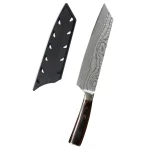In the realm of culinary artistry, knives are the unsung heroes that empower chefs and home cooks alike to create exquisite dishes. Yet, not all knives are created equal, and knowing which knife to use for each culinary task is akin to having the right brush for every stroke on a canvas. Let’s embark on a journey to explore the world of kitchen knives and discover the importance of choosing the right blade for each job.
The Knife Arsenal
Before delving into the specific tasks, let’s acquaint ourselves with some of the essential knives that every culinary enthusiast should have in their arsenal:
1. Chef’s Knife
The workhorse of the kitchen, the chef’s knife is a versatile, all-purpose knife with a broad, sharp blade. It’s perfect for chopping, slicing, and dicing a wide range of ingredients, making it a must-have in any kitchen.
2. Paring Knife
A small, nimble knife with a pointed tip, the paring knife is ideal for intricate tasks like peeling, trimming, and precision cutting.
3. Serrated Knife
With its toothed edge, the serrated knife is your go-to for slicing bread, delicate pastries, and ripe tomatoes without crushing them.
4. Utility Knife
A mid-sized knife, the utility knife strikes a balance between the chef’s knife and paring knife. It’s handy for a variety of tasks, from slicing sandwiches to cutting small fruits and vegetables.
5. Boning Knife
Designed for deboning meats and poultry, the boning knife features a thin, flexible blade that allows for precise maneuvering around bones.
6. Santoku Knife
Hailing from Japan, the Santoku knife boasts a shorter, wider blade with a slightly curved edge. It excels at slicing, dicing, and chopping, especially for vegetables.
7. Cleaver
The cleaver is a heavy-duty knife primarily used for butchering and chopping through bones. It’s a staple in Chinese and Asian cuisine.
Matching Knives to Tasks
Now that we’re acquainted with our culinary comrades, let’s match knives to specific tasks:
1. Chopping Vegetables
For tasks like chopping onions, bell peppers, or carrots, reach for the chef’s knife. Its broad blade and rocking motion make quick work of large vegetables.
2. Peeling and Trimming
When you need to peel and trim small fruits or vegetables or devein shrimp, the paring knife is your trusty companion. Its precision is unmatched.
3. Slicing Bread
For that perfect slice of artisanal bread or delicate cake, rely on the serrated knife. Its saw-like edge ensures clean cuts without crushing.
4. Carving Meat
When it’s time to carve a roast chicken or slice a prime rib, the carving knife comes into play. Its long, slender blade creates uniform slices.
5. Deboning
For removing bones from meat or filleting fish, the boning knife shines. Its flexibility allows you to get close to the bone without wasting meat.
6. Asian Cuisine
If you’re delving into Asian cuisine, the Santoku knife is versatile and excels at slicing, dicing, and chopping vegetables and boneless meats.
7. Butchering and Heavy-Duty Tasks
When tackling heavy-duty tasks like butchering a whole chicken or cleaving through bones, the cleaver is your weapon of choice.
8. All-Purpose
When in doubt or if you have limited knife options, the utility knife is your jack-of-all-trades. It can handle a wide range of tasks with ease.
Conclusion
In the world of culinary creativity, choosing the right knife for each task is akin to selecting the perfect brush for an artist’s masterpiece. Each knife has its unique role, and mastering their usage is key to becoming a skilled chef or home cook. So, the next time you step into the kitchen, remember that the right knife is your trusty ally, ready to transform your culinary visions into delicious reality.






